A while back, I posted to my Instagram account a patient’s non surgical revision nose job before and after photos. The San Francisco patient wasn’t happy with her surgical rhinoplasty results from another doctor. She felt that the tip of her nose appeared “pinched” and the angles a bit exaggerated. She visited my office to see if we could improve the appearance by creating more natural, healthy-looking contours. It took 3 separate treatments spread out over about a year, but the results were worth it.
One of the commenters on that post said most surgeons recommend not getting fillers after having rhinoplasty surgery and asked how I was able to “work around” the issue. In this post, I’d like to share my response and emphasize the importance of choosing a highly trained and experienced surgeon to perform non surgical revision rhinoplasty.
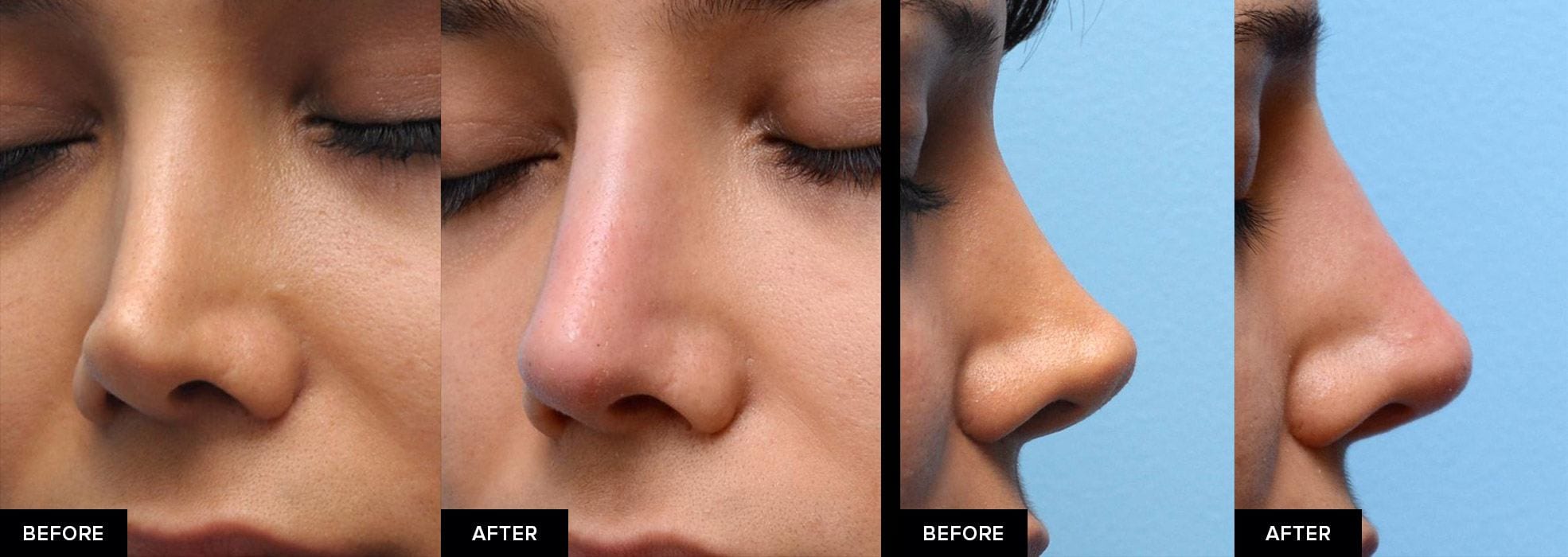
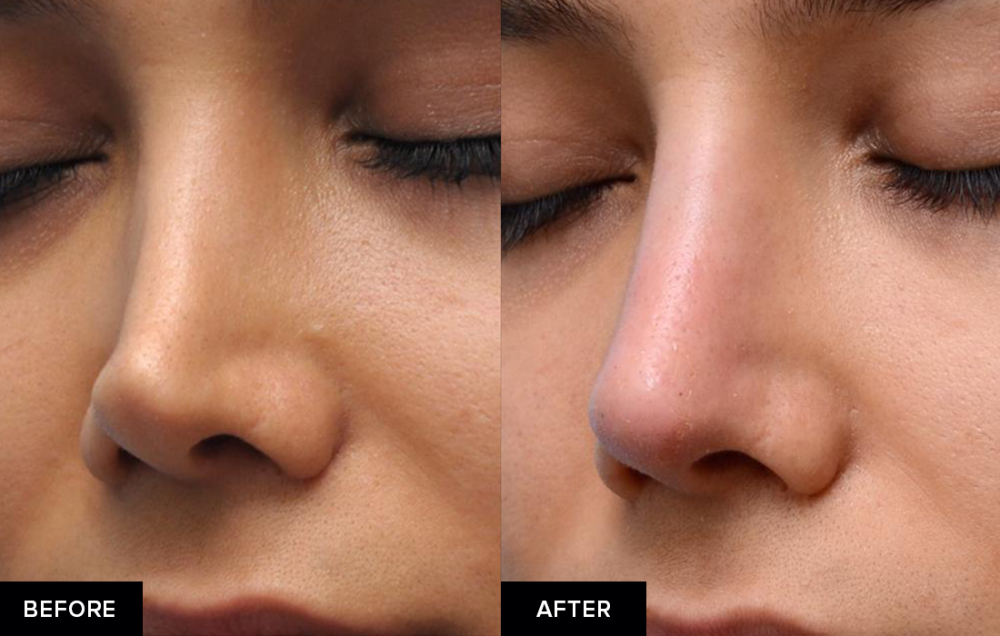
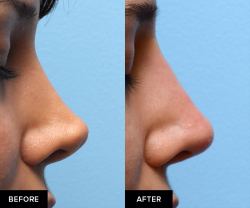
Using Filler To Reshape the Nose: The Benefits of Non surgical Revision Rhinoplasty
Some patients are unsatisfied with the appearance of their nose after surgical rhinoplasty, but are hesitant to undergo a second revision surgery. Fortunately, non surgical revision with filler can be a safe alternative with excellent outcomes for a few reasons.
Less Trauma = Less Risk
Revision surgery can create new trauma, new scar tissue, and the possibility of damage to the nose when performing the procedure. The surgery is invasive whether patients are looking to make big or small modifications to their initial outcomes. Every time you separate the skin, you are disrupting the blood supply with a possibility of weakening the structure of the nose that can cause new problems.
Fillers, on the other hand, can:
- Address areas without disrupting the internal anatomy
- Require no general anesthesia
- Results are immediate

Shorter Recovery
Patients can be concerned about undergoing general anesthesia and a long recovery process where it could take an additional 6 to 9 months for final results to be visible. Swelling onset during surgery can make predicting outcomes challenging. What looks good in the operating room may change over time during the healing process. Millimeters can make a big difference! Fortunately, non surgical revision rhinoplasty with filler can be a safe alternative with excellent, immediate results and high patient satisfaction.

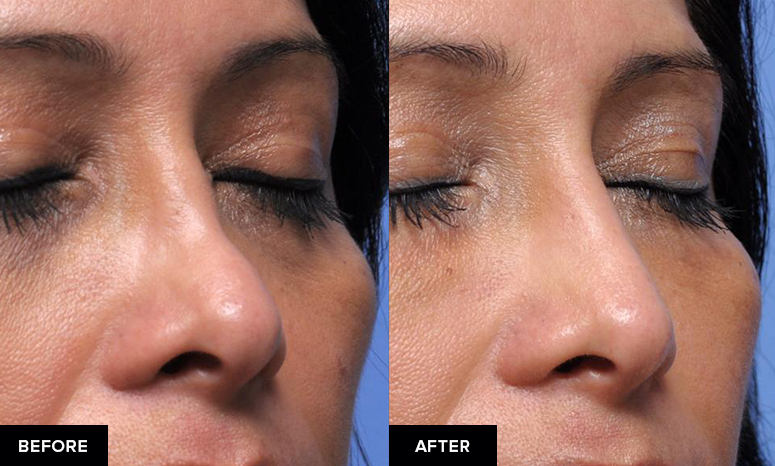
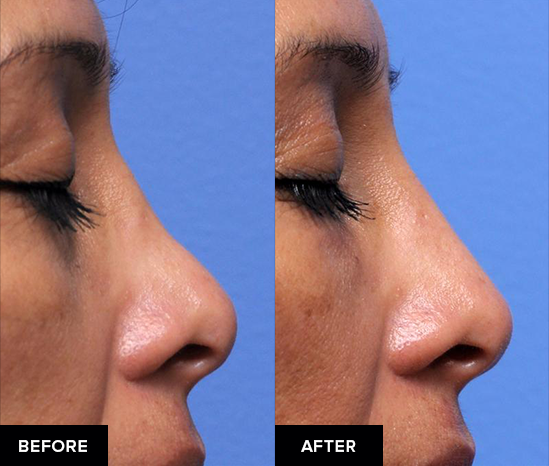
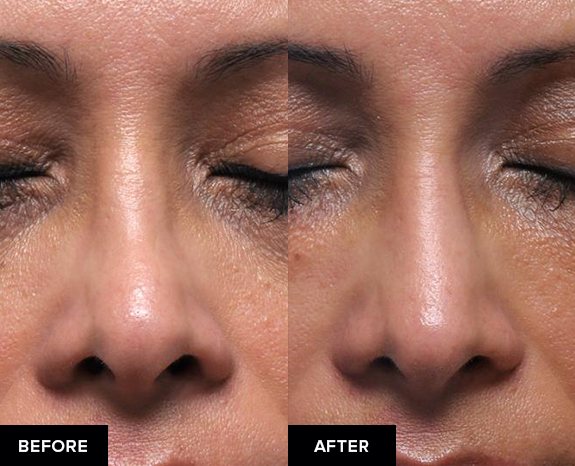
Better for Rebuilding the Nose
Many patients that consult with me after surgical rhinoplasty elsewhere have had a lot of reduction (bone and cartilage have been removed), creating an irregular contour. The gelatinous nature of fillers makes it easier to rebuild and create a smooth contour. Using a microcannula, the application feels like painting. Fillers can be applied in a precise, controlled manner, unlike using an implant (synthetic or harvesting cartilage). The gel-like substance is ideal for soft, predictable results.
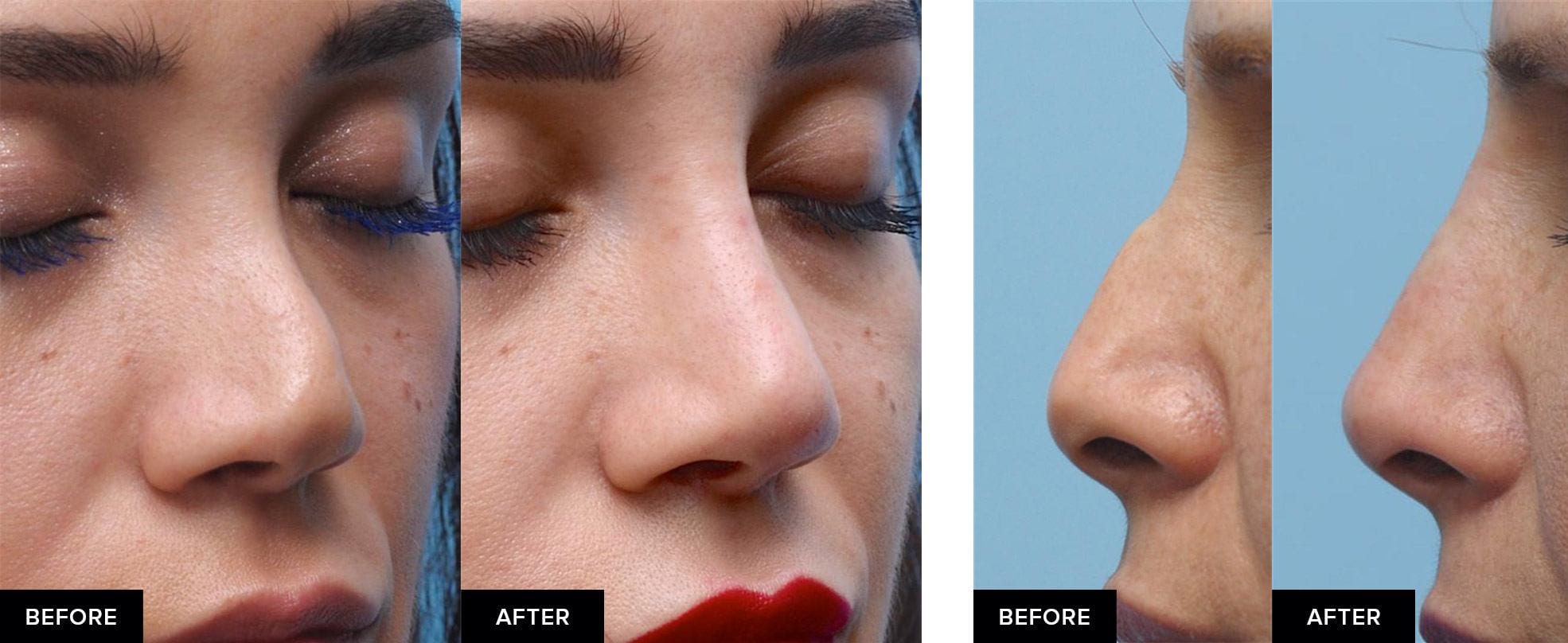
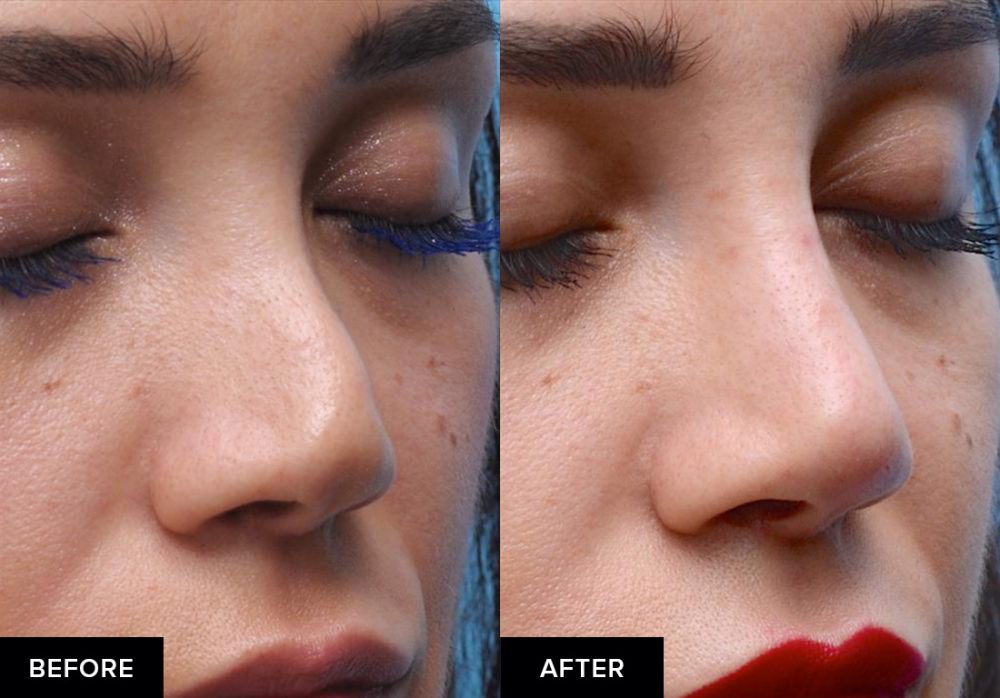
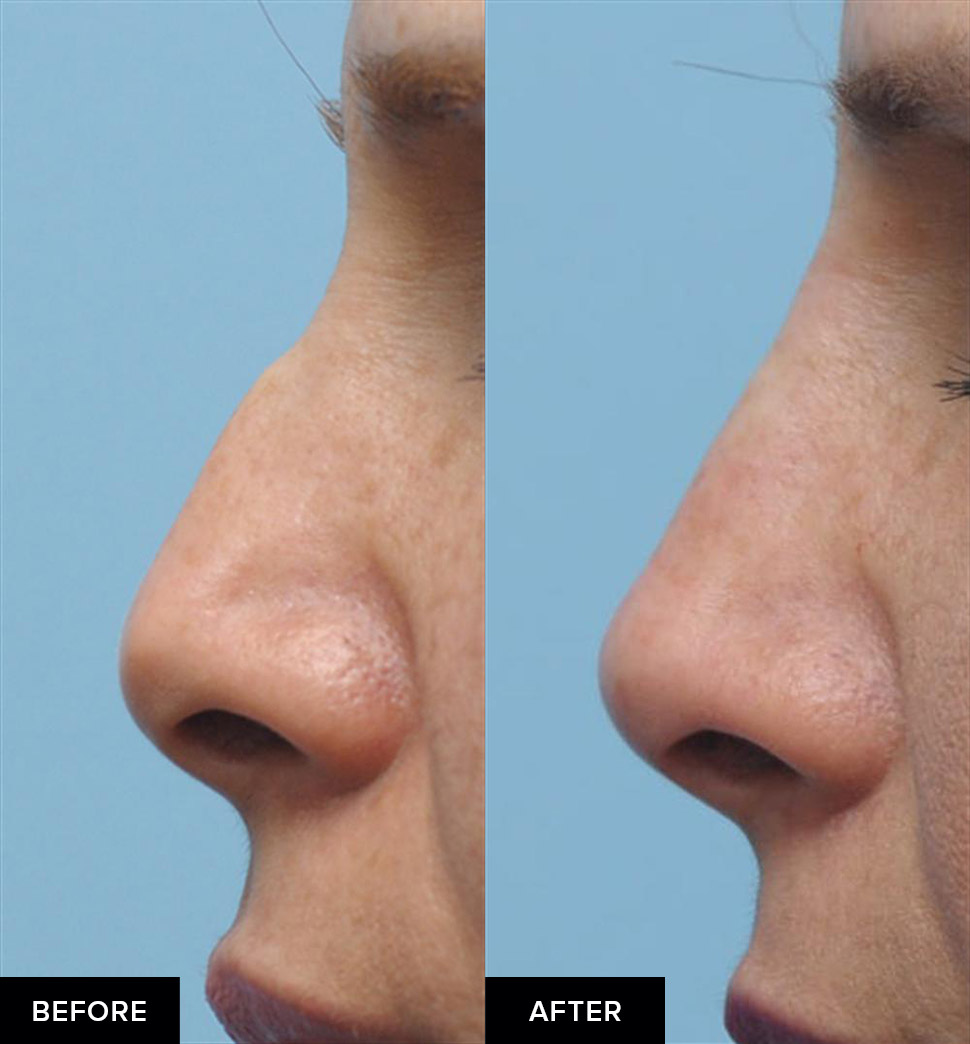
Significantly Lower Cost
Non surgical revision rhinoplasty costs a fraction of surgical fees. Revision rhinoplasty surgery can be more difficult and costly than the initial surgery because of the higher medical risk. Surgical rhinoplasty and revision costs can often exceed $20k.

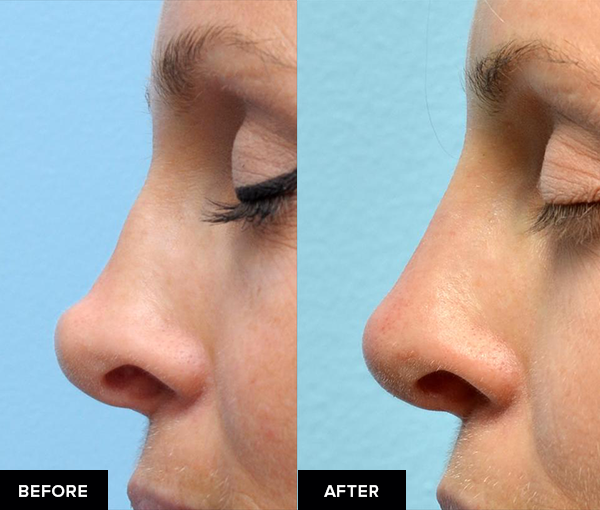
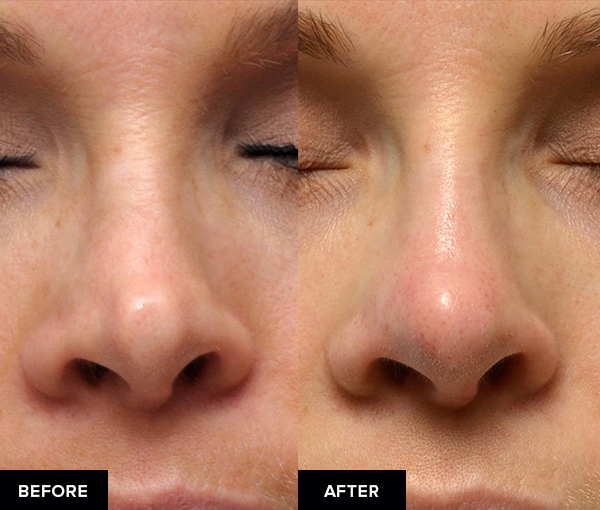
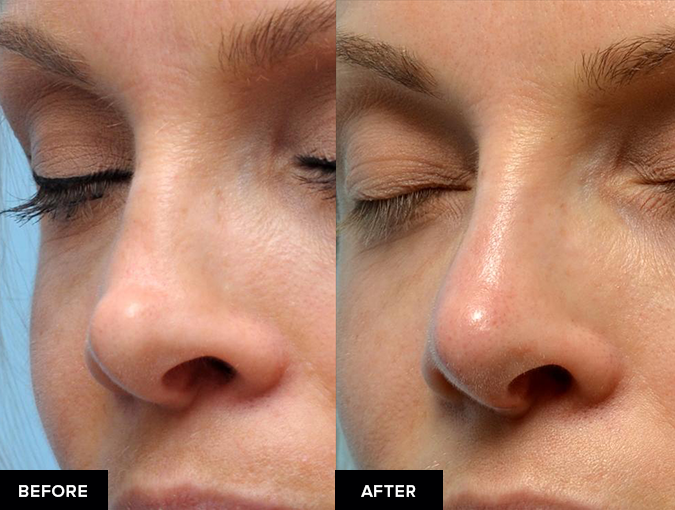
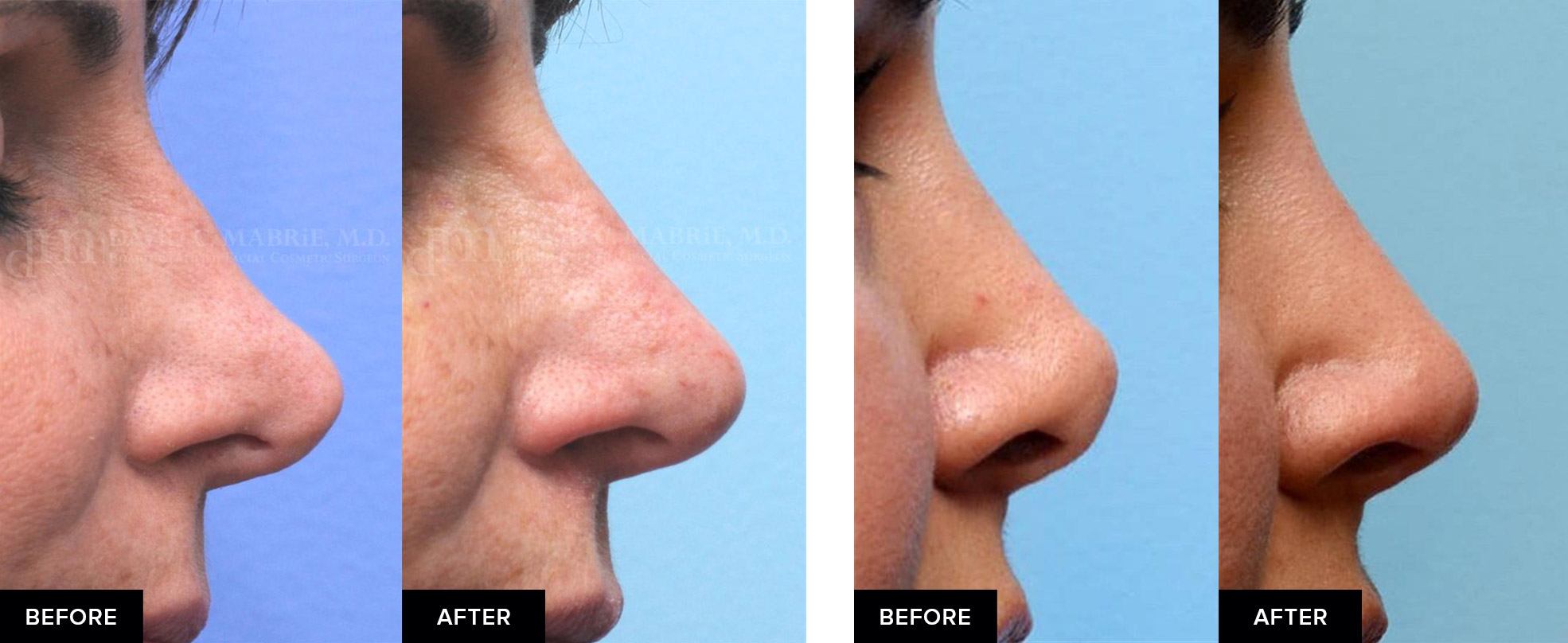
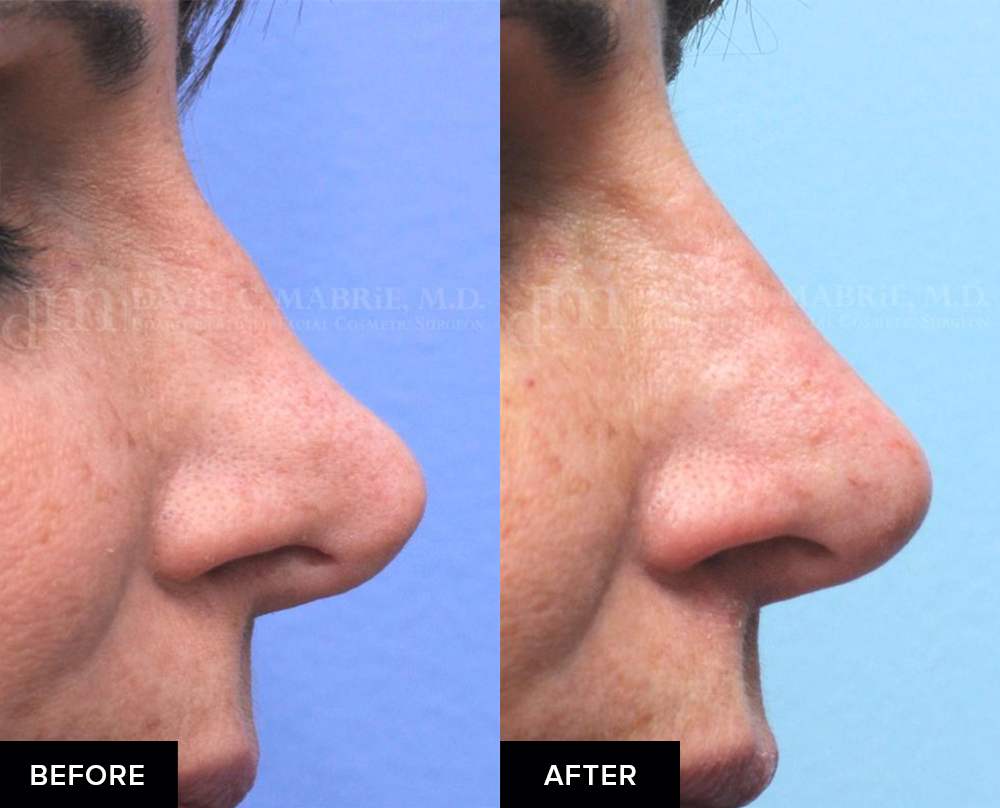
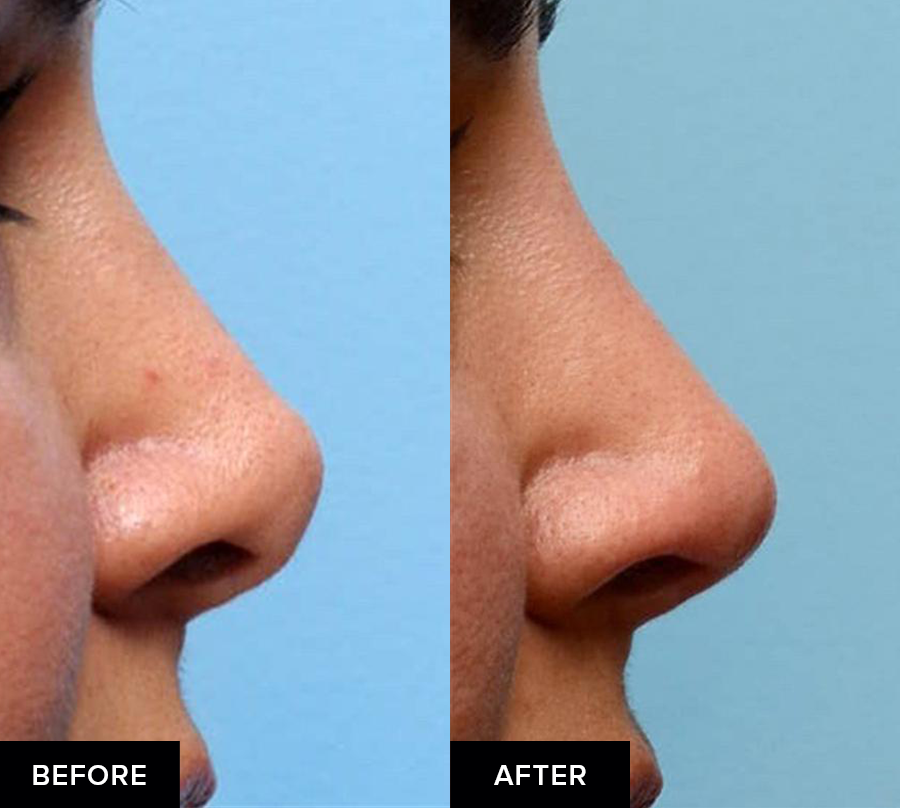
Risks of Nose Filler After Rhinoplasty Surgery
Non surgical revision rhinoplasty is an excellent alternative to revision rhinoplasty surgery, but it is not without risks.
Bruising and swelling are common side effects; however, more serious complications can include infection, vascular occlusion (injecting into an artery), and, in rare cases, blindness. Vascular occlusion can lead to tissue necrosis and scarring. Patients with prior nasal surgery may be at increased risk for vascular compromise due to altered blood supply and scarring to the area.
Minimizing Risk: Choose a Qualified Injector
When considering non surgical rhinoplasty, choosing an experienced, expert injector is vital to patient safety. Suspected vascular occlusion should be treated immediately by dissolving filler. Vascular occlusion can rapidly progress to tissue necrosis if not identified and treated quickly. An experienced injector should be prepared with safety protocols and the tools necessary for optimal patient safety.
In my office, we are prepared to address any adverse events and also increase the safety of this procedure by:
- Using a blunt-tip microcannula to avoid puncturing an artery
- Avoiding high-risk, vascular areas
- Treating areas of vascular occlusion with hyaluronidase to dissolve the filler
I do believe that getting non surgical rhinoplasty from the outset, for many patients, can produce even better results than surgery, which is why I’m so passionate about the procedure. It can be part of my Illumination 360° treatment process, in which I correct, define, and refine a person’s features to optimize their looks. You can learn more about the procedure in this previous blog post.
Learn More
If you’re considering non surgical rhinoplasty and want to learn more about the procedure, please contact us using our online form or by calling us at (415) 445-9513. Our Concierge Team is available to answer your questions or to schedule a time for your initial assessment with Dr. Mabrie.

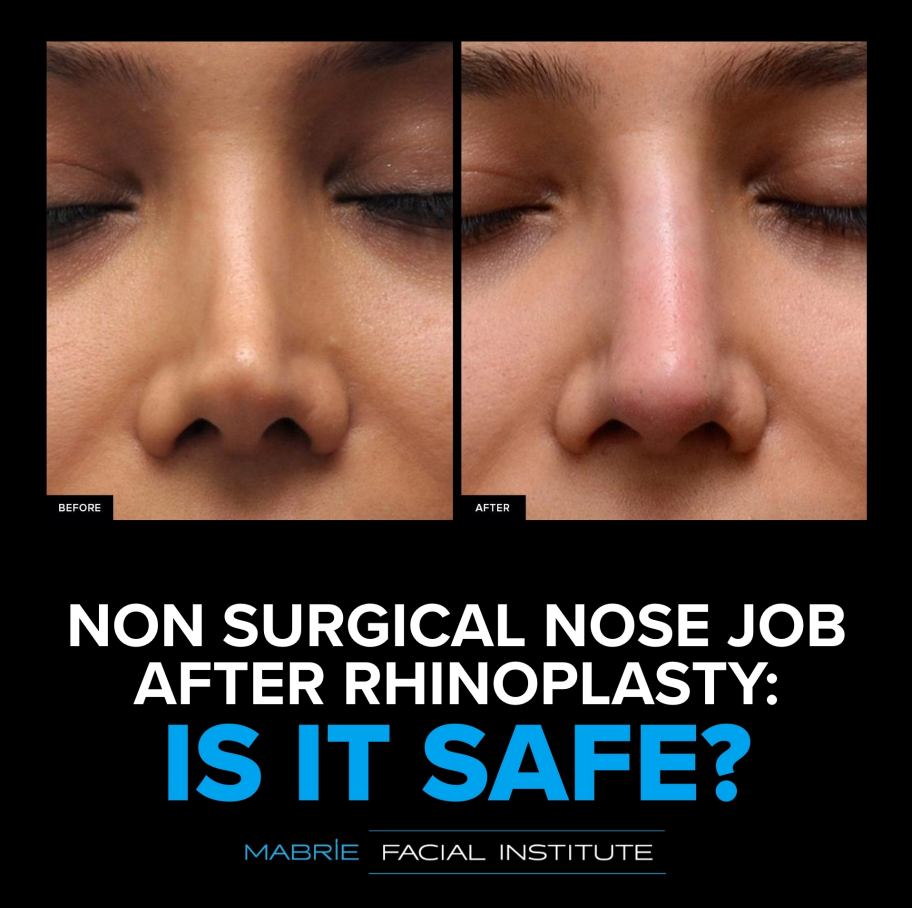
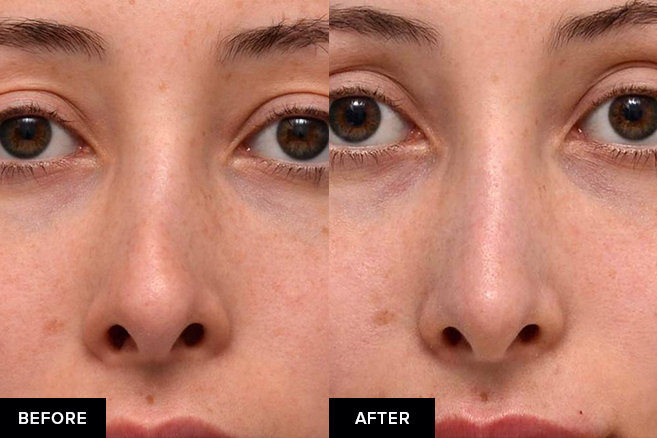
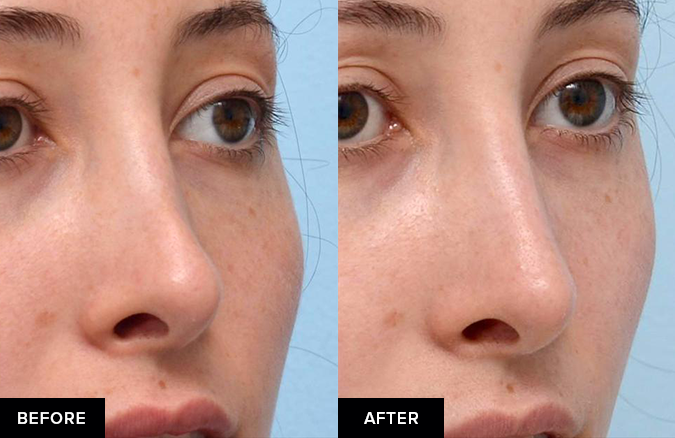
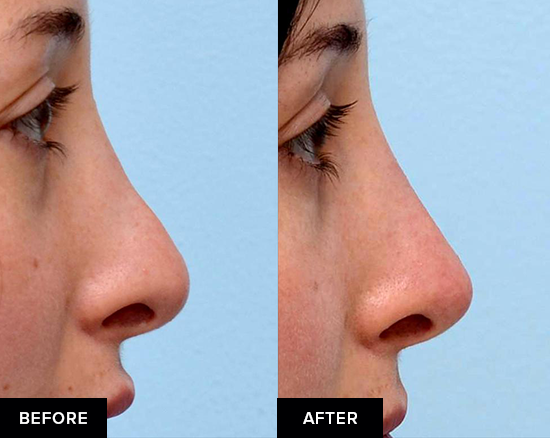
How long do the effects last? Will they fade after 1-3 years, or..?
Thanks.
Hi Monica – Thank you for checking out our blog. Nonsurgical rhinoplasty uses filler to shape and define the nose. Typically, results last 9-12 months. We recommend touch-ups yearly to keep your results looking fresh. Without maintenance, the results will gradually fade overtime. You can learn more about nonsurgical rhinoplasty on our website where we feature an extensive before/after photo gallery of our patient results, as well as treatment videos. If you have additional questions or if you would like to know if you’re a candidate for nonsurgical rhinoplasty, give us a call. We’re happy to assist you.
I don’t care for the idea of having to get periodic touch-ups. Do you ever use permanent fillers like bellafill for this treatment?
Hi Sheryl ~ Thank you for checking-out our blog and your question. Nonsurgical rhinoplasty is a great way to shape and define the appearance of the nose without surgery. While the procedure has gained popularity in recent years, it is not without risks. If you are considering nonsurgical rhinoplasty is important to find a skilled, experience Injector familiar with nasal anatomy. Nonsurgical rhinoplasty is a technically challenging procedure and in the hands of a skilled Injector can highlight and contour the nose. I prefer to use a hyaluronic acid (HA) based filler, often Restylane, for the nose because of its consistency. It provides excellent lift and projection for the area. I also prefer to use a dissolvable filler for patient safety and aesthetics. If, for any reason, we aren’t happy with the results, the filler can be dissolved with the use of hyaluronidase. Bellafill, while semi-permanent, cannot be dissolved and also requires periodic touch-ups. Based on the risk/benefits of both fillers, I prefer to use the HA. After your initial treatment, maintenance at 9-12 month intervals to keep your results looking fresh. I hope that helps!
Hi Sheryl ~ Thank you for submitting you question about nonsurgical rhinoplasty and permanent filler. I prefer to use a hyaluronic acid based filler (like Restylane) because of its consistency and reversibility. Reversible fillers are important for patient safety and satisfaction. If, for any reason, we are unhappy with the results we can dissolve it. While Bellafill is a longer-lasting filler, it is not reversible and does require touch-up. Nonsurgical rhinoplasty results can last up to 1 year with yearly touch-ups recommended to keep your results looking fresh.
Would massaging the filler into the nose where there is a dent/depression not cause further problems? (ie. more of a sunken appearance once the filler wears off and/or pushing the filler substance down and creating breathing problems?)
Hi Marcie ~ Thank you for checking out our blog and submitting this great question. Massaging the filler after nonsurgical rhinoplasty will not cause the filler to move or create a dent/depression. You can wear glasses, sleep naturally, and continue daily activities after treatment. Filler placement occurs under the skin and does not alter the anatomy; therefore, will not cause breathing problems. We recommend yearly maintenance treatments to keep your results looking their best.
Hi Dr,
I’ve filler for 7 months, but I’m going to do surgery for the rhinoplasty on next July. However, the filler still present, can I do dissolve it?
Thank you,
Hi Trisha – Thank you for your question about dissolving nonsurgical rhinoplasty fillers. Depending on the filler used, dissolving before your surgical procedure is possible. Hyaluronic Acid (HA) based fillers, like Restylane or Juvederm can be dissolved by injecting an enzyme (Hyaluronidase) to areas where the fillers are placed. This enzyme dissolves the filler to water that is absorbed into the body within 24-48 hours after application. Fillers that are not HA-based (Radiesse, Bellafill) cannot be dissolved. In my practice, we only use HA-based filler for nonsurgical rhinoplasty. I hope that helps and best wishes for your surgery.
I recently went under a rhinoplasty in December 2018 and the results aren’t what I hoped for. there are some minor irregularities that I would like fixed with filler around July/ August 2019 time. is that enough time or would I need to wait for a longer period before getting fillers?
HI
I HAD RHINOPLASTY WITH ENT SURGEON FREE ON NHS THIRTY FIVE YEARS AGO, WHICH SEEMED LIKE A GOOD IDEA AT THE TIME. IT WASNT> RUBBISH RESULT, REVISION A YEAR LATER, STILL RUBBISH IF NOT WORSE, ESPECIALLY ONE SIDE, FAST FORWARD 20 YEARS , AN ENT SURGEON WHO IWAS SEING FOR SOMETHING ELSE COMMENTED THAT HE COULD FIX THE PROBLEMS I HATED, A WATSE OF TIME.MY NOSE LOOKS ENORMOUSLY BEAKY FROM ONE SIDE ESPECIALLY.i WAS EXSTATIC WHEN I DISCOVERED THE NON SURGICAL NOSE JOB, BUT NOW DISAPPOINTED TO READ , IT MAY BE MORE CVOMPLEX HAVING IT, IF THE PATIENT HAS HAD RHINOPLASTIES ALREADY. ITHOUGHT FOR ME I WOULD BE COMPROMISED. i LIVE IN UK LANCASHIRE, CAN YOU RECOMMEND AN EXPERT , AND IS IT RISKY AFTER ALL THIS TIME?
Hi Elizabeth ~ Thank you for sharing your experience with surgical rhinoplasty. I’m sorry to hear that you’re unhappy with the results after revision. Nonsurgical rhinoplasty could be an option even after revision surgery. Your Injector will let you know whether you’re a good candidate for the procedure. If you like, you can send in some photos for a Virtual Assessment, but keep in-mind that the best course is to meet with an experienced Injector in an office setting. Many of my patients travel from the UK for treatment. I’d be happy to schedule some time for us to meet.
Dear Dr. Mabrie,
After a revision open rhinoplasty (for excess columellar show), I now have a retracted columella — which is substantially higher than my alar margin. Can filler be used in the columella after open rhinoplasty? Can it also be used in the nostrils? If it’s possible to use dermal fillers in those areas, how many months or years after the revision rhinoplasty can filler be safely used in the columella or nostrils? (My initial rhinoplasty was a closed procedure, 21 years ago.)
Thanks very much for your guidance!
Hi Anna – thank you for checking out our blog about Fillers After Surgical Rhinoplasty and your questions. Fillers can be used in the columella and nostrils after surgical rhinoplasty. I suggest waiting about 4-6 months post-operative before making a filler appointment. When searching for an Injector, it is important to find an Expert Injector with experience performing nonsurgical rhinoplasty after surgery. I cannot stress this enough. Nonsurgical rhinoplasty is an anatomically challenging area. When adding altered anatomy from surgery, it is even more critical for the procedure to be performed by someone familiar with nasal anatomy and injecting. If you’re in the San Francisco Bay Area or plan to travel here, please give our office a call. I am happy to help you. I hope that helps.
I have the exact same problem after a revision rhinoplasty.
I have a dent in the tip of my nose and retracted collumella.
I am wondering of tgis can be improved with fillers.
Hi Bee – Thank you for checking out our Blog, “Are Fillers Safe After Rhinoplasty” and for your question. Dermal fillers can be very effective in improving contour irregularities (in this case – your dent at the nasal tip and retracted columella) after revision rhinoplasty surgery. It is important to find an Expert Injector for nonsurgical rhinoplasty. After 2 surgeries, anatomy and scare tissue can present challenges to an Injector without experience with this particular procedure. Be sure to do your homework when consulting with any practitioner to confirm that they are experienced, skilled, and knowledgeable with nonsurgical rhinoplasty and has demonstrated results (before/after patient images). I’m happy to see you in-office or do a virtual consultation for a personal assessment.
Hello Dr. Mabrie
I had a chin construction in 1997, the result was a bit out of my aspect ,if looking at it carefully will see it shifted to the right side.But, now in the recent time,about a few years, it show obviously too much to the right side ,it makes me lost confident to see and talk to people.
I was thinking of bellafill for the left side of my chin to make it even but I was 59 years old , I don’t known if I can do it or not,please give me an advise when you have a chance. Thank you
Hi Hannah – thank you for question about Bellafill and nonsurgical chin augmentation. If your implant has shifted, I suggest consulting with your surgeon to re-position and re-attach the implant. Fillers are not the best way to correct asymmetry from an implant that has moved. Typically, a permanent suture is used to keep the implant secure. If the implant is no longer attached, adding filler could cause an increased risk of infection to the area. I hope that helps.
I am 3 months post op. My surgeon wants to put a little filler in my nose for some minor irregularities that are showing due to how I’m healing. Skin wrap etc. Is it possible to do without high risks?
Hi Dawn – thank you for your question about the risks of nonsurgical rhinoplasty (NSR) after rhinoplasty surgery. NSR is a safe, effective, treatment to correct nasal contour irregularities and shape the nose when performed by an experienced Injector. It is an excellent option to correct “minor irregularities” you mention in your comment, because fillers can be placed precisely to address concavity and/or asymmetry from surgery. The outcomes from NSR are also more predictable than revision surgery. That being said, as a medical procedure, NSR it is not without risks. Scar tissue and altered anatomy after surgery can present challenges to an inexperienced Injector. Be sure to have a conversation with your surgeon to ask questions and address any of your concerns before moving forward.
Hi doc, after nag pa dissolve ng nose filler at namaga. Normal side effect po ba yan or na infection?
Hi BHE – I’m unsure if I understand your questions. Please send me an email to: [email protected]. Thank you for checking-out the blog.
Hi! Can you put fillers in to a nose with goretex implant?
Hi Helen – nonsurgical rhinoplasty can be performed after surgical rhinoplasty using an implant. Patients with previous rhinoplasty surgery can present an elevated risk for nonsurgical treatment; however, the procedure is possible. Be sure to find a provider with demonstrated experience with nonsurgical rhinoplasty. I hope that helps.
Hello dr
M Sanober from uae I need to know after how many months after a Rynoplasty I can do filler on my nose , basically I need correct my nostril shape by fillers
Hi Sanober – thank you for your question. In general, nonsurgical rhinoplasty can be performed about 6-9 months after surgery. However, the can vary based on your recovery. I suggest speaking with your surgeon before seeking nonsurgical treatment if it’s been under 1 year.
I have had 5 Rhinoplastys over 40 years, my nose looks like it’s been operated on, it has dents and abnormalities especially down the right side. I also suffer pain from the right side. I have had filler in the past and that has helped the pain and made it look more presentable. The fillers have now worn away, so the pain is back. The problem I face is that I know how risky it is to have fillers and have seen what can happen with the nose turning black because of Necrosis. I feel frightened to hsve more, but fillers help with the pain down the right side of nose.
Hi Teresa – I’m sorry to learn of your complications after rhinoplasty surgery. It sounds like you had positive results after your nonsurgical rhinoplasty, but are concerned about retreating the area due to possible risks. With all medical procedures, there are risks involved with treatment. Patients with previous rhinoplasty surgery, can have an elevated risk with nonsurgical rhinoplasty that can include vascular occlusion. However, treatment is possible. I suggest consulting with an experienced Injector that has demonstrated experience with the nonsurgical rhinoplasty procedure. Be sure to share your concerns of the risks and ask about the provider’s experience and protocols with adverse events. An expert provider will be happy to answer any of your questions and provide details to help you make an informed decision about treatment. I hope that helps.
Hello,
I was wondering if adding filler to the tip to give a more ‘downturn’ is possible. I recently got a rhinoplasty and am afraid that the tip, although not upturned, is not as downturned as I would like it. It seems a bit short for my face shape, which is a bit longer. Are you able to add filler to give the nose a natural droop?
Hi Jessica, thanks for reaching out, this is a great question! Yes, filler can be added to the nose to de-rotate the nasal tip. We recommend waiting 6 months post rhinoplasty for complete healing before injecting any fillers. I hope this was helpful, please feel free to reach out to us if you have any further questions or would like to come into our office for assessment.
I had surgical rhinoplasty making my tip smaller and bridge narrow. I miss my old nose. It has flattened my front view and i want more volume. Are you able to restore a bulbous tip and widen a bridge with filler? I know I won’t get my old nose back entirely but do you think it can be attempted? Also do you ever trial with saline first and if so how soon after can you inject the filler.
Hi H, thanks for reaching out and checking out our blog. Generally speaking, yes fillers can be used to widen the bridge and create a more bulbous tip if that is your aesthetic goal! Every patient’s anatomy is a little different, in order for us to give you a better idea of what could be possible with fillers and your nose I recommend a virtual assessment, which can be found on our website under the Let’s Connect tab. Our office can also perform a saline test first to give you a general vision of what is possible with fillers and your nose. Please keep in mind treatment cannot be done at the same appointment as the saline test.
Hello, I have a very similar situation to H. My nose was over “corrected” about 14 months ago and it is too small. My goal was for a much more modest aesthetic. I would be grateful if you could clarify how much width and height for my tip and bridge is typically possible to achieve with fillers. Also what if I feel that after the fillers, a surgical revision rhinoplasty would be needed down the road, how will having filler affect the surgical outcome?
Hi Jessica, great question thanks for reaching out! While nonsurgical rhinoplasties can increase the height and width of your tip and bridge, to what extent, is based on each persons anatomy. The best way to determine if you’re a good candidate for a nonsurgical approach, is to have a virtual or in person consultation. This would allow us to evaluate your current anatomy and review your inspired goals (inspo photos are a great tool!). One of the great things about a nonsurgical rhinoplasty is that the filler is dissolvable. If you chose to have a surgical procedure after filler, we would dissolve your filler prior to your procedure. At our office, we ONLY use dissolvable filler for the nose. If you are interested in setting up a consultation please give us a call at 415-445-9513, we’d love to see you. Hope this was helpful.
Hello, I have some questions about the non-surgical revision rhinoplasty. If a patient were to have a pinched nose similar to the “before” picture in the Instagram post, what sorts of changes would be appropriate to achieve a fatter nose, like fattening the alar-nostril sills and the tip? Would the fillers be able to give a patient a dorsal hump if that is what the patient desired? A good example of a goal would be Sana Minatozaki’s nose. What would you think would be required to go from the pinched upturned “before” nose in this article to her (Sana Minatozaki’s) nose?
Hi Gracie, thank you for reaching out with this question! At our office we can use dermal fillers to customize the appearance of one’s nose. Dr. Mabrie strategically places filler to help match your goals, and yes it’s possible to widen the nasal bridge and tip, as well as create a dorsal hump if that is the patients goal. In terms of exact placement of filler we suggest coming to the office for an in person consultation so we can evaluate the current anatomy of the nose and generate a treatment plan specific to your goals. If you have any further questions feel free to reach out to us at [email protected], hope this was helpful!
hello doctor, I would like to have your opinion, I had a septorhinoplasty more than 3 years ago but it left me with an inverted V, I don’t want to go through surgery now, I want to pass the going for injections but after having read a lot of articles on the internet the risk of blindness is really worrying me! how is it that the risk is increased after an R1? can the vessels go to another “plane” i’m really scared to go inject and go blind with everything i’ve read
Hi Laura, we appreciate you reaching out and understand your concern. It’s true that filler injections to the nose are at a slightly higher risk for vascular occlusions, and having a previous surgical rhinoplasty increases the risk slightly. Blindness is extremely rare, if you’re considering having this procedure done it’s very important to find an injector that has many years of experience performing these injections. We suggest having an in-person evaluation with your potential injector so they can evaluate your current nasal anatomy to better determine whether or not you would be a good candidate.
Hi doctor. I’ve had a rhinoplasty this year and my nose bridge got too slopy and scooped out. Am I a good candidate for fillers? I want my nose bridge to be straight again:(. Also I’m so concerned about the risks of getting fillers to my nose I’ve read articles about it and they made me so scared. I can’t look at myself from the side I want this trauma to end:(. Should I be hopeful and go get fillers?
Hi Ella, I’m sorry to hear you didn’t have a great experience with your surgical rhinoplasty. The good news is fillers may be a great option for you! We see many patients who use filler as a way to make corrections to their surgical results. Filler can be used to build and reshape the nasal bridge. In general, we recommend waiting 6-months after surgery before considering fillers; this gives time for swelling to resolve so your new anatomy can be accurately examined. It is best to have an in-person consultation with your injector so they can assess your specific anatomy and determine if you’re a good candidate for fillers. Be sure to see a highly experienced and qualified injector.
Hello! I have a question about fixing a retracted columella and the area right above the columella. I had trauma to that area from a bad septum piercing and caused a lot of cartilage to come out and cause retracting to my columella and the tip of my nose. Thanks!
Hi Kashmir, thank you for your question! I’m sorry to hear about your bad experience from your septum piercing. In regards to treating a retracted columella with dermal fillers, it truly depends on the individual anatomy. Sometimes dermal fillers can be used to improve the appearance, other times the anatomy limits what is possible. It is best to have an in-person examination with a highly qualified injector to evaluate the area and potential space for filler. Hope this was hopeful, if you have any further questions or would like to schedule an appointment with Dr. Mabrie please give our office a call at 415-445-9513.
Hello, i have a question. What happens when we stop touching up these nose fillers after 10 years? Will our nose look distorted or a different shape from the original when we decided to stop touching up?
Hi Sarah, thanks for reaching out, excellent question! There typically is no distortion for anyone who discontinues filler to the nose after years of having treatment. What patients find is that over time as their filler dissolves their nose returns to its natural anatomical shape. Hope this was helpful!